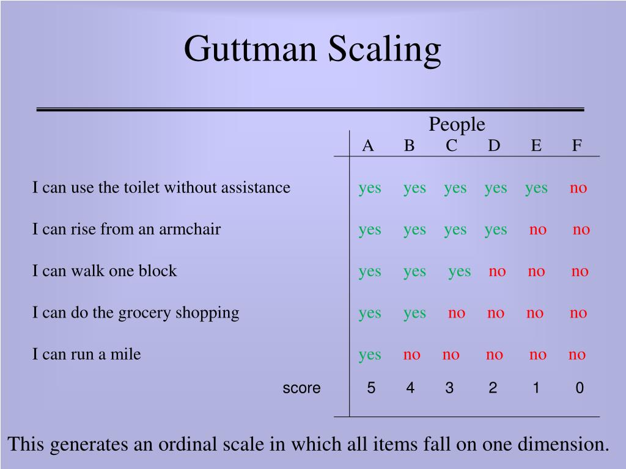
Louis Guttman’s scale measures the beliefs and opinions of individuals and is named after its inventor. In simpler words, it calculates how an individual responds to an opinion by evaluating their level of agreement and disagreement.
Researchers have used the Guttman scale in everything from marketing to political science. Furthermore, this scale allows the researchers to determine an individual’s attitude toward a subject and give it a numerical value.
How is the Guttman Scale Unidimensional?
This scale computes an individual’s positive or negative response to a statement or opinion. It is specifically unidimensional, as it measures only one factor at a time.
What are Characteristics?
The Guttman Scale has the following characteristics:
- The items ordered on the scale are from least difficult to most difficult. In case the respondent has scored 6 on the scale, indicating that they agree with 6 out of 10 items on the scale.
- The items featured on the scale are homogenous, which means that they can be measured similarly. It is important in comparison.
- The items on the scale are positioned from least to most useful.

What is the Purpose of the Guttman Scale?
In order to determine the level of approval or disapproval of the items presented, the Guttman scale presents a series of statements. The researchers use the scale to identify patterns in the answers and frame conclusions. Based on the analysis, you can determine whether respondents have positive or negative attitudes.
For example, a respondent scores 10 out of 50 on a cumulative scale. An assumption can be made that the respondents agreed with the first 10 statements out of 50 through the use of the Guttman scale.
Introduction to Guttman Analysis
The aim of this analysis is to measure the depth of relationships between more than two variables on the scale. The statements or questions are ordered in a way to intensify the statement or question more than the one before, which is why. The Guttman scale provides a frame-work for the researchers so that they can make an accurate analysis of the subject.
For example, you asked someone whether they liked pizza. They might say yes or no. They might even give you a maybe.
But if you ask them how much they like pizza on a scale of 1 to 10, it will give you a better idea of how the respondent truly feels about pizza. Researchers can quantify it.
The Guttman analysis looks at how people rate different things on a scale and then puts those ratings into different categories. This can help you understand how people feel about different things.
This type of scaling is also known as “one-fact” or “monotone” scaling. Another example of the scale:
- Item 1: I believe that recycling is important.
- Item 2: I recycle regularly.
- Item 3: I sort my recyclables before placing them in the recycling bin.
- Item 4: I rinse my recyclables before placing them in the recycling bin.
- Item 5: I buy products made from recycled materials whenever possible.
A respondent’s score on the Guttman scale is determined by how many items they agree with. If a respondent agrees with all the items, then he or she is said to have a perfect score. If a respondent disagrees with any of the items, then he or she is said to have a non-perfect score.
Advantages of the Guttman Scale
- Easy to understand: The scale is easy to use and understand as it is a simple ranking of items on an ordinal level.
- Reliability: The scale is highly reliable as the items are arranged in an orderly fashion, which makes it easier to assess the reliability of the scale.
- Flexibility: Researchers can benefit from the high flexibility the scale offers.
- Validity: This is highly valid as it ensures that the items are arranged in a logical order and that the responses are consistent with the overall pattern of the scale.
- Efficiency: It also offers efficiency as it requires fewer resources and time to administer and analyze.
Limitations of the Guttman Scale
Some limitations that should be taken into account when using the scale:
- The scale relies on a set of predetermined statements and items. It’s not always easy to identify the right statements that accurately align with the topic of the study. Additionally, the order of the items might influence the responses, as participants might respond based on the order rather than their true opinion.
- It is only useful for measuring attitudes toward a single issue. A Guttman scale may not be the best approach for measuring a complex attitude that involves multiple factors.
- A large sample size can produce inconsistent results if the items or responses are changed, but it is still not always reliable.
In Conclusion
Guttman scales are useful for measuring attitudes on a single issue, but they may not be the best approach for complex topics. Additionally, the predetermined statements and order of items might influence the responses, and the scales may not be reliable if the items or responses are changed.

